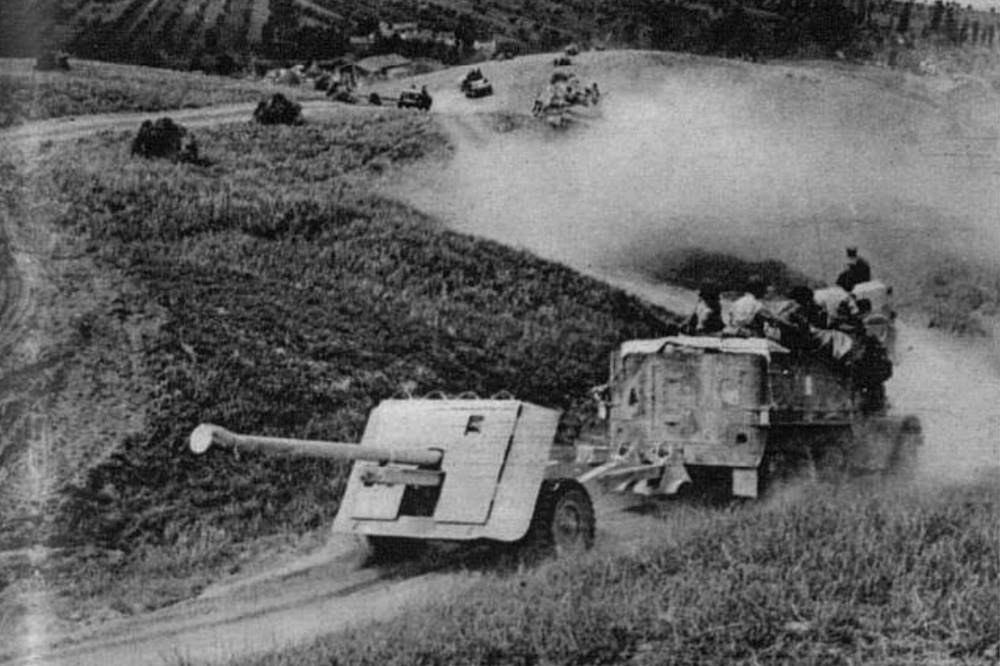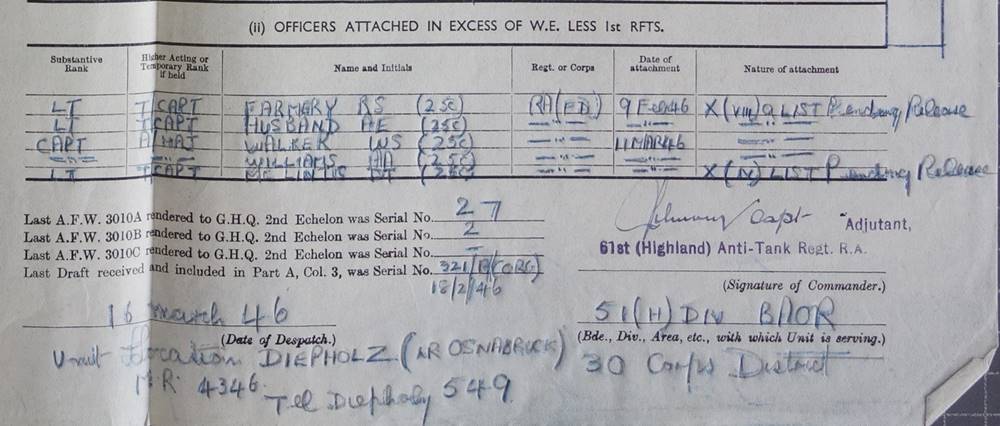This article looks at the role of an anti-tank regiment of the Royal Artillery during the Second World War. As well as explaining what an anti-tank regiment was, this article will help you find records to research the units as well as the soldiers who served with them. This is one of a series of articles I’ve written to help you in your research:
I also offer a Second World War Soldier Research and Document Copying Service.
An Anti-Tank Regiment Royal Artillery
An anti-tank regiment was a unit of the Royal Artillery whose purpose was to destroy tanks. Each infantry division had a single anti-tank regiment and most served with this type of formation. As anti-tank guns had a limited effective range, they were deployed either close to or on the front line, in highly camouflaged positions, often sited to cover a road or strongpoint. As well as their main role in destroying tanks, anti-tank regiments were also used to provide artillery support. The anti-tank guns used by anti-tank regiments varied during the war and you’ll have to consult a unit’s records to find out what they used. Early in the war, most anti-tank regiments were equipped with the 2-pounder, though a small number used the 25 mm Hotchkiss. These were subsequently replaced by the 6 and then 17-pounders. Self-propelled guns were also used by anti-tank regiments later in the war. The photograph below shows a 17-pounder of an unknown anti-tank regiment being towed by an M3 half-track in Italy in 1944. A good book to provide an overview of the weapons used by anti-tank regiments is British Anti-tank Artillery 1939-1945 by Chris Henry.

The following war establishment for an anti-tank regiment was “notified in Army Council Instructions for the week ending 29th June, 1938” and was in use early in the Second World War. The war establishment of an anti-tank regiment changed during the war and also depended on the theatre in which it served. If you check a unit’s field returns which often appear when it was serving outside of Britain you may find the war establishment it was using recorded. The establishment outlined below was II/1931/7/3.
An anti-tank regiment consisted of a regimental headquarters and four batteries. Each battery was divided into three troops of two sections, each of which contained two anti-tank guns. This gave an anti-tank regiment 48 guns in total. Batteries, each of which contained twelve guns, were “self-contained and may be detached for long periods”. An anti-tank regiment was commanded by a Lieutenant-Colonel with a Major as second-in-command. Each battery was commanded by a Major and in total, there were seventeen officers. In addition, there was a Medical Officer attached from the Royal Army Medical Corps. Then there were 521 other ranks from the Royal Artillery and an Armourer from the Royal Army Ordnance Corps, later the Royal Electrical and Mechanical Engineers. This gave an anti-tank regiment a total strength of 543 all ranks. A signal section from the Royal Corps of Signals was usually attached to an anti-tank regiment.
The regimental headquarters was the smallest part of an anti-tank regiment as it contained six officers, including the Medical Officer and forty-five other ranks including the armourer. This gave the headquarters a strength of fifty-one all ranks. Each battery contained three officers and 120 other ranks for a total strength of 123 all ranks. Of the other ranks serving with the regiment, fifty-six had passed a trade test in a specific skill. These included twelve Artificers, twenty-eight Driver Mechanics and five Technical Storemen.
How to Research an Anti-Tank Regiment
The most important document to research an anti-tank regiment is its war diary. This was written by an officer of a unit and recorded its location and activities. They often include appendices in the form of maps, orders, battle reports etc. Without a unit’s war diary, it will be very difficult to research an anti-tank regiment. All war diaries are held at the National Archives in London and I offer a copying service for these documents. Some anti-tank batteries also kept war diaries and these will be an important source of information, especially if you know which battery a soldier served with. There may also be war diaries for an anti-tank regiment’s signal section. Also, the war diaries of infantry battalions an anti-tank regiment operated with can also be very useful for researching specific battles or engagements.
Most anti-tank regiments served with an infantry division and therefore another source of information will be the Commander Royal Artillery’s war diary. This will cover all the artillery units serving with the division and you’ll usually find appendices missing from an anti-tank regiment’s war diary in it. An important book for quickly finding out which division an anti-tank regiment served with is Orders of Battle Second World War by Lieutenant-Colonel H. F. Joslen. If you can’t view a copy, you can often find which formation an anti-tank regiment was serving with by consulting its war diary. Below is an extract from the 61st (Highland) Anti-Tank Regiment’s field return of officers dated 16 March 1946. At the bottom right-hand corner of this document which is usually found when a unit was serving outside of Britain is a line to write the “Brigade, Division, Area, etc. with which Unit is serving”. On 16 March 1946, the 61st Anti-Tank Regiment was serving as part of the 51st (Highland) Division of the British Army of the Rhine (B.A.O.R.). The war diary of the 61st Anti-Tank Regiment covering March 1946 is WO 171/9027 and that for the 51st Division’s Commander Royal Artillery WO 171/8773.

Another source of information for an anti-tank regiment is the citation cards for any gallantry awards or honours its soldiers received. These are part of the WO 373 series at the National Archives and have been digitized. They often help to supplement information found in a unit’s war diary when it was in action. Map references are often recorded in citations. The National Archives charges a small fee to download each citation but they are free to download if you visit the National Archives.
How to Research a Soldier who Served with an Anti-Tank Regiment
The most important document to research a soldier who served with an anti-tank regiment is their service record. In most cases, unless you’re researching a casualty or have documentation on a soldier, it will be impossible to research them without their service record. This is due to the fact that a service record is the only document which will provide you with all the units a soldier served with and the dates they were with them. Without knowing which anti-tank regiment/s a soldier served with, you won’t be able to research them. A service record will often provide you with the battery a soldier served with within an anti-tank regiment but this won’t always be the case. Service records are held by the Ministry of Defence and I’ve written a guide to ordering a copy.
There are two important sources of information online for soldiers who served in the ranks of the Royal Artillery. The first is the Royal Artillery’s Tracer Cards, 1939-1948 on Ancestry. These documents record a soldier’s movements between different units but only a small portion of those who served in the Royal Artillery during the period have a card. Also, they don’t always begin when a soldier joined the Royal Artillery but often many years into their service. Despite these problems, if you do find a card to a soldier you’re looking for, they can provide you with a lot of important information which will enable you to start your research. A soldier’s service record will contain far more information than what is found on their tracer card. There is a lot of military jargon on the cards in the form of abbreviations and acronyms.
The second important source of information online is the Royal Artillery attestation records covering the period between 1883 and about mid-1942. These can be viewed on FindmyPast. If a soldier joined the Royal Artillery between this period and served in the ranks, they should appear. However, the very detailed entries stopped around 1929. From this date, only three columns appeared, one recording a soldier’s army number, the second their name in full and the third titled “Transfers to other Corps or cause of becoming non-effective and record of re-enlistment (if any) (Including date)”. Only fragments of information appear but you may see a unit recorded for a soldier, often written beneath their army number. Unfortunately, the dates a soldier served with the unit weren’t recorded.
Also, available on FindmyPast are the British Army’s casualty lists between 1939 and 1945. If a soldier died during the war, went missing, was wounded or taken prisoner of war they should appear in these lists. The unit a soldier served with was often recorded which will enable you to look at the unit war diary on that date to find out if the circumstances which led to the casualty are recorded. Sometimes, the unit a soldier served with wasn’t recorded and it will just provide a list of casualties who served in the Royal Artillery. Another important source of information on FindmyPast is the digitized newspapers of the British Library. These are particularly useful if you’re researching a soldier who became a casualty or was awarded an honour, or gallantry medal. Only a small fraction of newspapers from the Second World War have been digitized but more are being continually added.
If the soldier you’re researching died between 3 September 1939 and 31 December 1947, you can find where they are buried or commemorated on the Commonwealth War Graves Commission’s website. An entry will also record the soldier’s date of death, their number, possibly the unit they were serving in at the time and additional information. Sometimes, the battery a soldier of the Royal Artillery was serving in was recorded as well as the regiment, though they may just be listed as Royal Artillery. Once you know the unit a soldier was serving with when they died, turn to its war diary to see if it provides more information.
